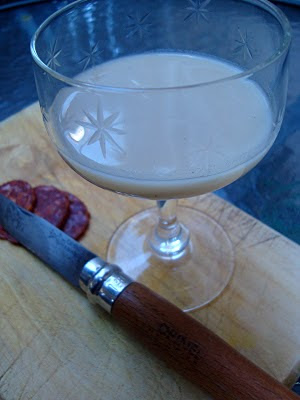One of the most important things
that distinguish man from other animals
is that man can get pleasure from drinking
without being thirsty.
~ Fernand Point
is that man can get pleasure from drinking
without being thirsty.
~ Fernand Point
Not long ago, I plucked a 1974 copy of Fernand Point’s Ma Gastronomie from the shelf. Point was the French chef/restaurateur of La Pyramide, a renowned temple of gastronomy south of Lyon. I was looking for his recipe for a sort of simple French milk punch. Though he died in 1955, his life and work continue to inspire chefs today. Marc Vetri, for instance, whose restaurant Vetri Mario Batali claimed was possibly the best Italian restaurant on the East Coast, used to keep the same copy of Ma Gastronomie in his kitchen. Thomas Keller, no slouch in the kitchen, has written an introduction to a new edition of the cooking classic and it’s worth tracking down if, like me, you're into food as well as drinks.
The recipe I was hunting (from the oversized yellow-jacketed 1974 edition) is for a homemade liqueur that Point used to take with him as he went to survey the quality and maturity of the grapes of the Côte Rôtie. Reputedly, he would stop now and again on the steep slopes of the vineyards and take a swig of a tasty little pick-me-up he called Liqueur du Grapillon (or “Liqueur for the Grapes”).
The recipe calls for an entire lemon, cut into quarters, to be thrown in with brandy, milk, and vanilla. Citrus and dairy in the same drink can lead to some chewy disasters. They can be—and often are—combined without incident, but keep this formula in mind: [citrus + milk] = [curds + whey]. Fortunately, since the lemon is not squeezed into the mix and, as this mixture sits in the dark for almost two weeks, any curds formed are very small and easily strained out.
 The result is a smooth, thick and mildly sweet liqueur, similar to egg nog but not as thick and without the eggy overtones, tasting of whole milk, vanilla, and cognac. After a few days of macerating, I tasted the drink and was leery: the lemon was overpowering, sharp, and biting. Resisting the temptation to yank it out of the jar (after all, presumably Point knew something about successfully combining tastes), I left it in and was rewarded after another week with a mellowed liqueur that no longer tasted like furniture polish.
The result is a smooth, thick and mildly sweet liqueur, similar to egg nog but not as thick and without the eggy overtones, tasting of whole milk, vanilla, and cognac. After a few days of macerating, I tasted the drink and was leery: the lemon was overpowering, sharp, and biting. Resisting the temptation to yank it out of the jar (after all, presumably Point knew something about successfully combining tastes), I left it in and was rewarded after another week with a mellowed liqueur that no longer tasted like furniture polish.On the last day of the decade, I poured myself a short glass, grabbed some dried sausage and a pocket knife, and moseyed out to the patio to read the paper and soak in the beautiful sun of Southern California. There are no grapes to survey, but the palm trees look mighty fine.
Liqueur du Grapillon
(“Liqueur for the Grapes”)
Combine sixteen ounces of milk, eight ounces of sugar, sixteen ounces of very good eau de vie or brandy and add a lemon cut in thirds and a vanilla bean. Let the mixture stand, stirring from time to time. After 12 days, strain and serve.
~ Fernand Point (1974) Ma Gastronomie. Lyceum Books, Wilton, CT.
 Ingredient Notes: I’d used the vanilla pod in this recipe to make vanilla syrup as well as vanilla sugar, so a little bit of its moxie had been spent. To compensate, I used a pod and half, then, at bottling time, squeezed out all the remaining tiny black seeds as if from a tube of toothpaste into the strained liqueur.
Ingredient Notes: I’d used the vanilla pod in this recipe to make vanilla syrup as well as vanilla sugar, so a little bit of its moxie had been spent. To compensate, I used a pod and half, then, at bottling time, squeezed out all the remaining tiny black seeds as if from a tube of toothpaste into the strained liqueur.For milk, use whole milk, preferably unpasteurized. It really does make a difference. Don't even bother with 1%, 2%, or soy abominations. The brandy I used was Claude Chatelier VS, about $20/750ml at Trader Joe's. If using a waxed lemon, give it a good short scrub in hot water to remove as much of the coating as possible. Pluck it from the backyward if, like me, you live in places where mixers grow on trees.
Secondhand editions of Point's book are still around, but if you want to score the new edition, here's the skinny:
Fernand Point with introduction by Thomas Keller (2008)
Ma Gastronomie
240 pages, hardback
Publisher: Overlook/Rookery
1585679615
$40.00
.










 Set yourself up for being served some tasty beverages down the road by buying your little drinker some of Greg Boehm’s reproduction bartender manuals that include these drinks and hundreds more.
Set yourself up for being served some tasty beverages down the road by buying your little drinker some of Greg Boehm’s reproduction bartender manuals that include these drinks and hundreds more. For the record, here’s O. H. Byron’s 125-year-old recipe for the Hari-Kari
For the record, here’s O. H. Byron’s 125-year-old recipe for the Hari-Kari
















